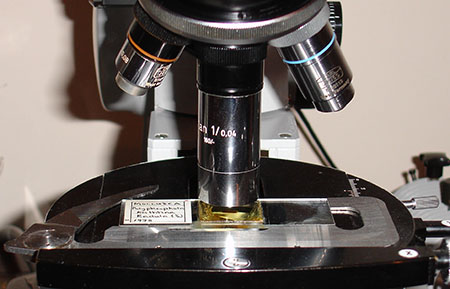
The Zeiss planachro 1x / NA0.04 is useful for visual work but to the author an impractical objective for
regular use with its size, non-parfocality and close working distance, shown above in focus.
Notes on studying and photographing prepared slides of larger subjects on a stereo microscope.
by David Walker, UK
Updated Dec. 2011. Comments on NAs of zoom stereo optics cf compound microscope objectives revised.
The lowest power objectives on a compound microscope are typically 2.5x and 4x. These are very useful but the field is still quite modest for many prepared slide subjects where the 'bigger picture' may be of value such as whole insects, crystal melts, thin rock sand large plant sections.
Some time ago I treated myself to one of the very low power objectives, a Zeiss plan 1x NA0.04 (other makers offer similar) but find it awkward to use and although not noticeable for visual work it seems to have a noticeable lack of 'bite' when used for photography. Dec. 2011. The comment comparing its NA to a typical zoom stereo has been removed, the NAs of stereos across their zoom range and specifically the NA at 1x is almost never declared, so direct comparison is not possible.

The
Zeiss planachro 1x / NA0.04 is useful for visual work but to the author an impractical
objective for
regular use with its size, non-parfocality and close
working distance, shown above in focus.
Dropping the mag of the eyepiece can help increase the field of view on a compound scope e.g. from typically 10x to 5x but on some models such as the Zeiss Photomicroscope, the optics don't seem to support eyepiece mags below 10x W. Changing the head from a bino to a mono can also help if it has a mag factor of 1.5x like the LOMO Biolam.
If a stereo is owned, this can be a good way of viewing and photographing the particularly large prepared slides to avoid a lot of scanning on the compound microscope. The typical lab stereo, e.g. the author's Meiji EMZ-1 1-3x zoom has an NA ca. 0.075 but the NA at it low power end is uncertain. (The lower NA budget stereos may not have the image quality to offer a better route over the compound, see this article for comparison of a budget and lab stereo imagery).
Comparison of optics at low power - compound v. stereo.
|
Microscope |
Optics |
NA |
Field of view / mm |
Working distance / mm* |
|
Compound (Zeiss PM III) |
Zeiss 1x planachro, 10x widefield eyepiece, 1.25 Optovar |
0.04 |
12.5 |
4.4 |
|
Compound (Zeiss PM III) |
Zeiss 2.5x planachro, 10x widefield eyepiece, 1.25 Optovar |
0.08 |
5.2 |
8.7 |
|
Stereo Meiji EMZ-1 |
1x - 3x optical zoom, 10x widefield eyepieces |
Dec. 11 update: ca. 0.075 at max end of zoom, but will be proportionately lower at 1x end. |
8 - 23 (15 - 45 with 0.5X adaptor) |
90 |
*
- from Zeiss and Meiji brochures.
Some practical aspects of studying prepared slides under a stereo using the Meiji EMZ-1 as an example are described below.
Even lighting: One of the potential problems on both a compound and stereo is even lighting for photography at low powers for transmitted work. On a compound scope the maker may have special low power condensers, swing in diffusers, lenses and / or recommend the condenser is removed. On the stereo the built-in transmitted lighting can be quite crude, even on a lab model like the Meiji EMZ-1, which just has a small filament quartz halogen lamp installed under two diffusers. It can be worth studying the maker's catalogues though, as on contacting Meiji Techno (UK) they suggested a higher quality diffuser than the standard filter for better photo work; it has certainly improved the author's Meiji EMZ-1.
If a stereo with a blank base with port and/or mirror is owned, these can offer more versatile transmitted light with the choice of an external large even light source or DIY lamp design (see footer for link to Ted Clarke's fibre optics lighting design). Some models now have fluorescent or LED lighting bases with more even lighting.
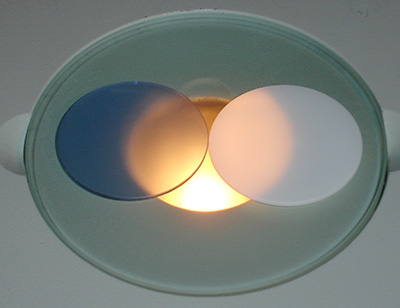
The Meiji EMZ-1 as standard is supplied with a glass diffuser (MA563/05), lefthand above, sitting under a larger diffusing plate. The filter MA566 available as an accessory, righthand above, gives far superior even lighting. The lighting from each of these filters is compared below.
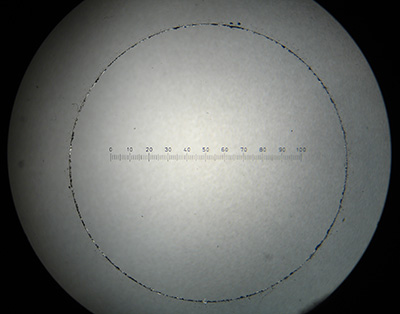
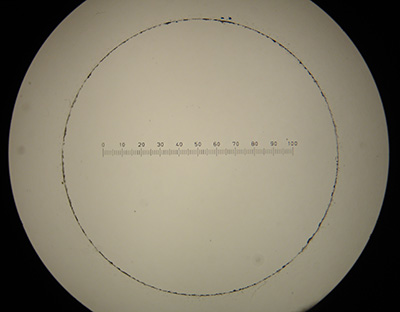
Meiji EMZ-1 full field of view 1x zoom, 10x eyepieces. The diffuser right offers a great improvement in the evenness of illumination and is also structureless. Colour balance changes can be corrected in camera. I suspect strong diffusers may effect the crispness of imaging in a similar way to its effect on compound microscopes, but haven't explored this. I tend to use a stereo for imaging bold structured subjects rather than fine detail, where slight loss of edge definition and possibly contrast can be corrected by a little image sharpening. Comments welcomed on the effects of diffuser on stereo imaging.
Photography: A trinocular version of a stereo can be very useful for permanently installing a camera on the microscope without interfering with the visual studies, however, they can be considerably more expensive. Unless it is one of the more upmarket models, the vertical tube may capture one of the eyepiece views, so it will retain the inherent angled view and distortions that can arise by supporting a camera over an eyepiece. Although this is easily corrected (see below). The makers of trino port stereos may offer a photo eyepiece which are more suited for projection than the bino' eyepieces.
With the advent of consumer digicams with small lenses, they can often be adapted to capture a field quickly from a bino eyepiece without interfering with visual work. If a support can't be devised or is not convenient, a suitable camera can be often held surprisingly steady by hand on an eyepiece if the stereo lamp is turned up to full intensity. The author routinely uses shutter speeds down to 1/30th handheld with no evidence of loss of critical sharpness.
The user may need to experiment on the best way of focussing the images in the camera. For the author's Sony P200 (similar to W7) the camera's autofocus works well with a contrasty subject visually focussed beforehand. The typical 3x optical zoom on a digicam can give the option of capturing full eyepiece field or zooming in to remove vignetting. But using both optical zoom on camera and mid to full zoom on stereo may give noticeable image degradation as the limitations of the stereo's modest numerical aperture becomes apparent.
With some ingenuity and engineering skills, a digital SLR may be supportable over an eyepiece as Ted Clarke has shown using an Olympus E-330 and 28 mm SLR lens as a relay optic. Michael Much shares another approach to attach an Olympus E-330 and Olympus compact digicams C-4040Z and SP020 to a stereo. Commercial camera adapters are also available for some camera models for a 30 mm stereo eyepiece tube or trino port, more typically 23 mm.
Taking photos with a Greenough stereo (i.e. with paired angled optics, rather than a common main objective, CMO): The optical axis of each eyepiece tube on a Greenough, is typically 5° to 6° to a perpendicular from the stage (ref. 1), so for photos of flat subjects that extend over most of field there maybe focus fall off; more evident in larger photos rather than those for web work and also at higher zoom settings on the stereo where depth of field is smaller. For the standard 3 inch microscope slide, propping up one end on a support ca. 6.5 - 8 mm high should present the flat slide at roughly 5 - 6° for photography using an eyepiece (either directly or via a trino port that uses one eyepiece view).
Meiji EMZ-1 stereo, 10x eyepiece, with and without slide
supported 7 mm one end.
(Micrometer slide focussed
visually down one eyepiece on centre.)

1x zoom on stereo, half
field, '100' focussed near field centre,
slide flat on stage. Loss of focus on the left field edge.

1x zoom, '100'
focussed near field centre,slide
supported 7 mm lefthand end. Focus even across field.
The improvement
is less obvious at 1x zoom as depth of field may partly correct.

3x zoom on stereo,
complete eyepiece field, slide flat on stage. Loss of focus on the left and right field edge.

3x zoom, complete
eyepiece field, slide
supported 7 mm one end. Focus even across field.
Studying large subjects: Whole insects and large botanical specimens for example can require a lot of visual scanning with a 2.5x compound microscope objective to appreciate the relationship between gross structures. Using a stereo to view these features can complement compound microscope studies.
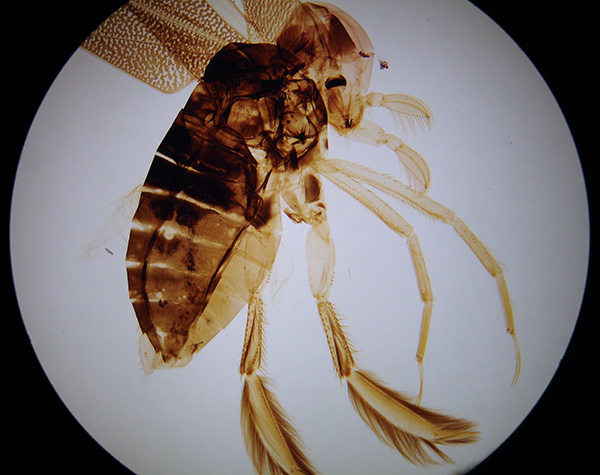
Water boatman, Corixa, 20 mm across. Prepared by author on NBS slide mounting course. Meiji 1x zoom, 10x eyepiece. A 0.5x extender for the stereo could be used if desired to image subjects in their entirety but can be quite an expensive accessory. Low colour temp of light corrected with auto white balance in Photoshop.
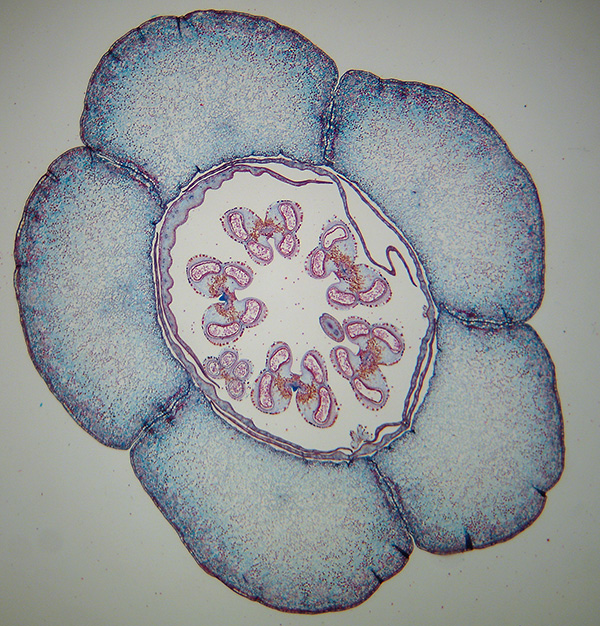
Madagascan flamboyant tree, Delonix, flower-bud T/S, Biosil slide, 14 mm across. Meiji 1x zoom, 10x eyepiece. Some optical zoom to crop out eyepiece vignetting. Low colour temp of light corrected with auto white balance in Photoshop. The camera detects residual light fall off but could be corrected in image editing software or with background subtraction if desired.
Polarising studies: Some large prepared microscope slide subjects may be 'active' under crossed polars and a stereo can usually be adapted quite readily for qualitative polar work.
Method 1: The filter thread on a Greenough stereo like a Meiji (typically 49.5 mm) or other make is often similar to that of a quality linear polariser which may already be owned for an SLR camera lens. So a step-up / step down ring or DIY attachment may be devised for analyser and a polariser placed below the subject. If the analyser is in a rotating mount this can also be useful. Michael Much described such a setup on an Olympus stereo.
Method 2: Only the field of view of the stereo needs to have polar lighting, so a cheap setup using small polar filter squares can be devised at little cost. An example is shown below.
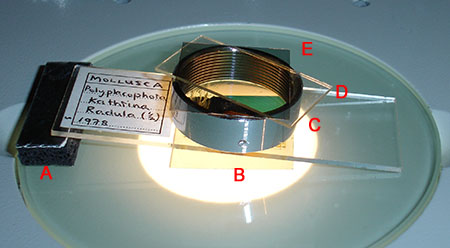
A
simple set-up for both visual and photo work on
a stereo with polarising filters.
A - 7
mm high
support (a piece of thick mouse mat was just right) gives ca.
5 - 6° angle to present
subject flat to one eyepiece.
B and E - polarisers,
small plastic sheets to cover field of view. Cutting
them square allows quick and accurate alignment in 'crossed'
mode. Plastic polar sheets are quite good value
and widely available from suppliers e.g. Knight Optical in the
UK.
C - metal collar holds the analyser and
retarder out of the plane of focus to avoid dust
etc being in image plane.
D - optional
retarder at roughly 45 degrees to polars.
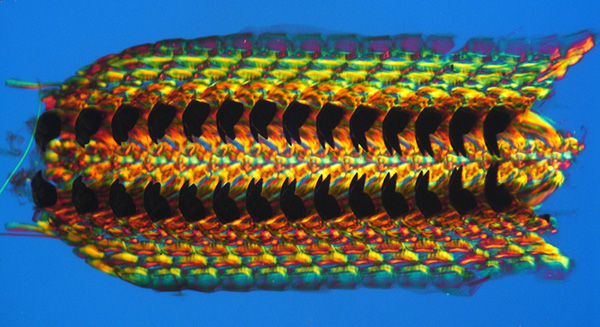
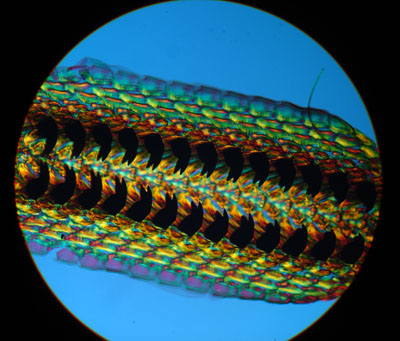
Snail
radula, Kathrina genus 6.5 mm long. Crossed polars
plus lambda tint plate. Slide prepared by John Atkinson (author's
brother in law) on a biology teachers' course. Sony P200 held
to the 10x eyepiece in each case.
Left: Meiji stereo 1x zoom,
10x eyepiece using polar setup shown above.
Right: Full eyepiece view of Zeiss 2.5x planachro NA0.08
on a compound microscope. Despite the modest subject size compared
with some subjects, it cannot be imaged in a single field. To
the author's eye, the Meiji EMZ-1 optics which has almost same
NA as the Zeiss 2.5x planachro, gives comparable image quality
at 1x zoom with the bonus of wider field and greater depth of
field. The diffused light source on the stereo rather than
a condenser of compound may affect imagery of some subjects.
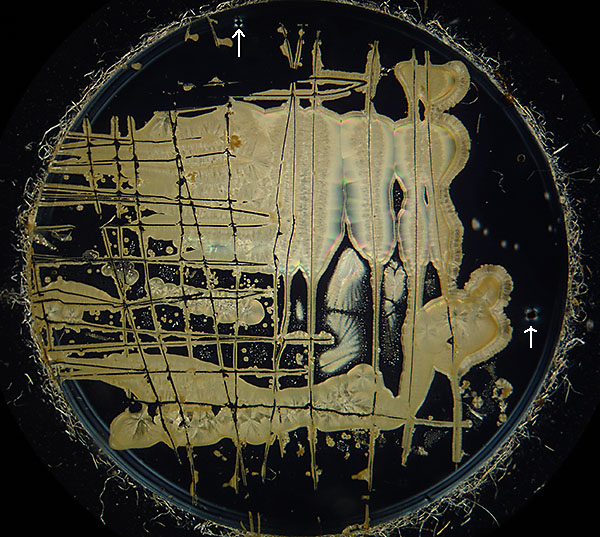
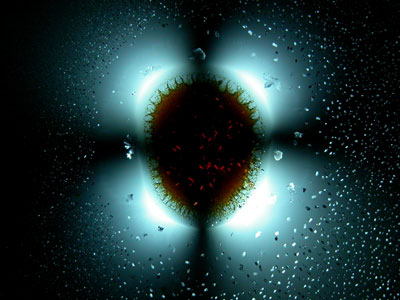
Vitamin C slide
(17 mm diameter cover slip), prepared by Mike Samworth, crossed polars.
Left,
Meiji Stereo. One of the benefits
of studying an 'active polar' subject first under a stereo before using the
compound, is that potentially interesting features may be spotted that a scan
of the slide at a higher mag under the compound may miss. The two arrowed features
could be overlooked, but my brother Ian spotted these and studied them more closely.
Right:
Image by Ian Walker of arrowed detail under a compound microscope to reveal the striking structure.
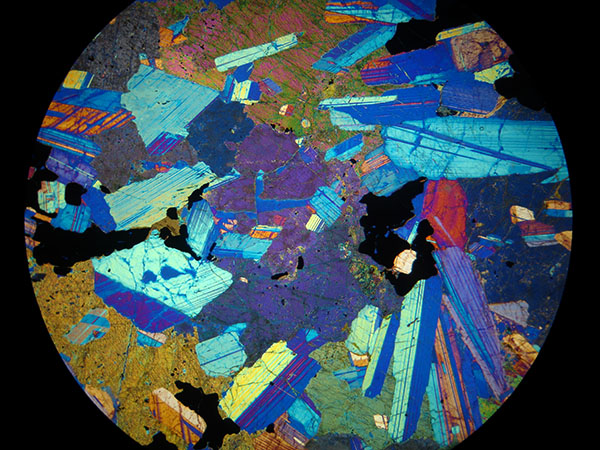
Eucrite (Gabbro), Geosec prepared slide. Meiji 1x zoom, crossed polars and lambda tint plate. First inspection of the whole field of a rock thin section may be useful to identify particular minerals of interest.
Comments to the author David Walker are welcomed.
Related Micscape
articles:
Hybrid polarising microscopes by Michael Much describing
adaptations to both compound and stereo models using Olympus kit as an example.
Using an Olympus E-330 DSLR
with a binocular stereomicroscope by Ted Clarke.
Three
stereo microscopes compared (Meiji SKC budget and Meiji EMZ-1 mid-price Greenoughs,
Leica MS5 CMO design) by David and Ian Walker.
Other articles:
'Multimode
trans-illuminator for the stereo microscope' by Ted Clarke. An ingenious fibre
optic based design allowing both brightfield and darkfield. 'Microscopy
Today' July 2007 Vol. 15 No.4 issue of Microscopy Today. With
thanks to Ted Clarke for drawing it to the present author's attention.
References:
1)
Introduction
to stereomicroscopy on Nikon MicroscopyU website.
Published in the November 2008 edition of Micscape.
Please report any Web problems or offer general comments to the Micscape Editor .
Micscape is the on-line monthly magazine of the Microscopy UK web site at Microscopy-UK
©
Onview.net Ltd, Microscopy-UK, and all contributors 1995
onwards. All rights reserved.
Main site is at
www.microscopy-uk.org.uk
with full mirror
at
www.microscopy-uk.net
.